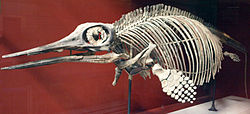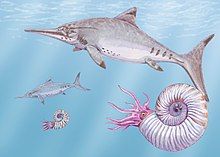「オフタルモサウルス」の版間の差分
編集の要約なし |
編集の要約なし タグ: サイズの大幅な増減 |
||
| 1行目: | 1行目: | ||
{{生物分類表 |
{{生物分類表 |
||
| fossil_range = [[ジュラ紀]]後期, {{Fossil range|165|160}} |
|||
| 名称 = オフタルモサウルス |
| 名称 = オフタルモサウルス |
||
| 画像 = [[File:OphthalmosaurusIcenius-NaturalHistoryMuseum-August23-08.jpg|250px]] |
| 画像 = [[File:OphthalmosaurusIcenius-NaturalHistoryMuseum-August23-08.jpg|250px]] |
||
| 画像キャプション = |
| 画像キャプション = オフタルモサウルスの骨格標本 |
||
| 地質時代 = JR |
| 地質時代 = JR |
||
| 地質時代2 = |
|||
| 省略 = 爬虫綱 |
| 省略 = 爬虫綱 |
||
| 亜綱 = ?[[広弓亜綱]] [[:en:Euryapsida|Euryapsida]]<br />?[[双弓亜綱]] [[:en:Diapsida|Diapsida]] |
| 亜綱 = ?[[広弓亜綱]] [[:en:Euryapsida|Euryapsida]]<br />?[[双弓亜綱]] [[:en:Diapsida|Diapsida]] |
||
| 13行目: | 13行目: | ||
| 下位分類名 = [[種 (分類学)|種]] |
| 下位分類名 = [[種 (分類学)|種]] |
||
| 下位分類 = |
| 下位分類 = |
||
*''O. icenicus'' <small>Harry Seeley, 1874 ([[模式種]])</small> |
|||
*''O. discus'' |
|||
| シノニム = |
|||
*'''''Khudiakovia''''' <small>Arkhangelsky, 1999</small> |
|||
}} |
|||
}} |
}} |
||
[[File:Yasikovia2.jpg|thumb|''Ophthalmosaurus yasikovi''の想像図]] |
[[File:Yasikovia2.jpg|thumb|''Ophthalmosaurus yasikovi''の想像図]] |
||
[[File:Ophthalmosaurus compared to human.svg|thumb|オフタルモサウルスと人との比較図]] |
[[File:Ophthalmosaurus compared to human.svg|thumb|オフタルモサウルスと人との比較図]] |
||
[[File:Ophthalmosaurus BW.jpg|thumb|オフタルモサウルスの復元図]] |
[[File:Ophthalmosaurus BW.jpg|thumb|オフタルモサウルスの復元図]] |
||
'''オフタルモサウルス'''( |
'''オフタルモサウルス'''([[学名]]:{{snamei|Ophthalmosaurus}})は、1億6500万年前から1億6000万年前にあたる[[中生代]][[ジュラ紀]]後期に生息していた[[魚竜]]の1種。全長約6メートルで[[イルカ]]に類似した姿をしており、歯のない顎は[[イカ]]の捕食に適していた。主な化石は[[ヨーロッパ]]と[[北アメリカ]]に分布している。 |
||
== 形態 == |
|||
[[File:Ophthalmosaurus compared to human.svg|thumb|left|オフタルモサウルスと人間の比較]] |
|||
オフタルモサウルスの体型は雫に似ており、尾ビレは半月状であった。前肢は後肢よりも発達しており、尾ビレで推進力を得て前肢で調整していたとみられている。 |
|||
半月型の発達した尾鰭を持っていたと推測されている。オフタルモサウルスの特徴としては、体と目の大きさの比率が大きく直径22 - 23センチメートルに達する点が挙げられる[http://mygeologypage.ucdavis.edu/motani/pdf/Motanietal1999.pdf][https://www.ncbi.nlm.nih.gov/pmc/articles/PMC1771016/]。眼球は頭部のほぼ全ての空間を占め、水圧に対し眼球の構造を維持していたとみられる[[強膜輪]]により保護されていた[http://www.ucmp.berkeley.edu/people/motani/ichthyo/eyes.html]。目と強膜輪の大きさから、オフタルモサウルスは日光のあまり届かない場所あるいは獲物が活発になる夜に狩りをしていたことが示唆されている。 |
|||
== 発見と種 == |
|||
アパトドントサウルス属、アンカナムニア属、[[バプタノドン]]属、[[モレサウルス]]属、[[パラオフタルモサウルス]]属、[[ウンドロサウルス]]属、[[ヤシュコヴィア]]属は[[2000年]]のMaischとMatzkeの論文ではオフタルモサウルス属のジュニアシノニムと考えられていた<ref name="Maisch & Matzke, 2000">Maisch MW, Matzke AT. 2000. The Ichthyosauria. ''Stuttgarter Beiträge zur Naturkunde Serie B (Geologie und Paläontologie)'' '''298''': 1-159.</ref>が、後の分岐学的解析によりモレサウルス属はオフタルモサウルス科の有効な属であることが判明した<ref name=DM10>{{cite journal |authors=Patrick S. Druckenmiller and Erin E. Maxwell |year=2010 |title=A new Lower Cretaceous (lower Albian) ichthyosaur genus from the Clearwater Formation, Alberta, Canada |journal=Canadian Journal of Earth Sciences |volume=47 |issue=8 |pages=1037–1053 |doi=10.1139/E10-028 |url=http://rparticle.web-p.cisti.nrc.ca/rparticle/AbstractTemplateServlet?calyLang=eng&journal=cjes&volume=47&year=0&issue=8&msno=e10-028 |bibcode=2010CaJES..47.1037D }}{{dead link|date=January 2018 |bot=InternetArchiveBot |fix-attempted=yes }}</ref><ref name=Fetal11>{{cite journal |last=Fischer |first=Valentin |author2=Edwige Masure |author3=Maxim S. Arkhangelsky |author4=[[Pascal Godefroit]] |year=2011 |title=A new Barremian (Early Cretaceous) ichthyosaur from western Russia |journal=Journal of Vertebrate Paleontology |volume=31 |issue=5 |pages=1010–1025 |doi=10.1080/02724634.2011.595464 |url=http://www.tandfonline.com/doi/abs/10.1080/02724634.2011.595464}}</ref><ref name=Acamptonectes>{{cite journal |author1=Valentin Fischer |author2=Michael W. Maisch |author3=Darren Naish |author4=Ralf Kosma |author5=Jeff Liston |author6=Ulrich Joger |author7=Fritz J. Krüger |author8=Judith Pardo Pérez |author9=Jessica Tainsh |author10=Robert M. Appleby |year=2012 |title=New Ophthalmosaurid Ichthyosaurs from the European Lower Cretaceous Demonstrate Extensive Ichthyosaur Survival across the Jurassic–Cretaceous Boundary |url=http://www.plosone.org/article/info%3Adoi%2F10.1371%2Fjournal.pone.0029234 |journal=PLoS ONE |volume=7 |issue=1 |pages=e29234 |doi=10.1371/journal.pone.0029234 |pmid=22235274 |pmc=3250416|bibcode=2012PLoSO...729234F }}</ref>。オフタルモサウルス・ナタンスはオフタルモサウルスの模式種よりも他のオフタルモサウルス亜科に近縁であることが分かり<ref name=DM10/><ref name=Acamptonectes/><ref>Ilaria Paparella; Erin E. Maxwell; Angelo Cipriani; Scilla Roncacè; Michael W. Caldwell (2017). "The first ophthalmosaurid ichthyosaur from the Upper Jurassic of the Umbrian–Marchean Apennines (Marche, Central Italy)". Geological Magazine. 154 (4): 837–858. doi:10.1017/S0016756816000455.</ref>、唯一利用可能な学名であるバプタノドン属の復活が必要とされている。ウンドロサウルス属の有効性は数多くの論文著者が認めており、ジュニアシノニムとしたMaischまでも有効性を受け入れている<ref name=Fetal11/><ref name=rus00>{{cite book |last=Storrs |first=Glenn W. |author2=Vladimir M. Efimov |author3=Maxim S. Arkhangelsky |year=2000 |chapter=Mesozoic marine reptiles of Russia and other former Soviet republics |title=The Age of Dinosaurs in Russia and Mongolia |editors=Benton, M.J.; Shishkin, M.A.; and Unwin, D.M. |publisher=Cambridge University Press |location=Cambridge |pages=140–159 |isbn= 9780521545822}}</ref><ref name="McGowan & Motani, 2003">McGowan C, Motani R. 2003. Ichthyopterygia. – In: Sues, H.-D. (ed.): ''Handbook of Paleoherpetology, Part 8, Verlag Dr. Friedrich Pfeil'', 175 pp., 101 figs., 19 plts; München</ref><ref name=Maisch2010>{{cite journal |authors=Michael W. Maisch |year=2010 |title=Phylogeny, systematics, and origin of the Ichthyosauria – the state of the art |url=http://www.palaeodiversity.org/pdf/03/Palaeodiversity_Bd3_Maisch.pdf |journal=Palaeodiversity |volume=3 |issue= |pages=151–214 }}</ref><ref name=Fetal11a>{{cite journal |last=Fischer |first=V. |author2=A. Clement |author3=M. Guiomar |author4=P. Godefroit |year=2011 |title=The first definite record of a Valanginian ichthyosaur and its implications on the evolution of post-Liassic Ichthyosauria |journal=Cretaceous Research |volume=32 |issue=2 |pages=155–163 |doi=10.1016/j.cretres.2010.11.005 |url=http://www.sciencedirect.com/science/article/pii/S0195667110001114 }}</ref>。さらにロシアの分類群2つも有効な属である可能性がある<ref name=Fetal11/><ref name=Maisch2010/> ''Ophthalmosaurus chrisorum''(Russell, 1993)は[[2010年]]にマクスウェルにより独自の属である[[アースロプテリギウス]]属に移された<ref name=MEE10>{{cite journal |last=Maxwell |first=E.E. |year=2010 |title=Generic reassignment of an ichthyosaur from the Queen Elizabeth Islands, Northwest Territories, Canada |journal=Journal of Vertebrate Paleontology |volume=30 |issue=2 |pages=403–415 |doi=10.1080/02724631003617944}}</ref>。パラオフタルモサウルスとヤシュコヴィアについてはオフタルモサウルスとは異なり明らかに有効な属である<ref>Storrs, Glenn W., Maxim S. Arkhangel'skii, and Vladimir M. Efimov. 2000. Mesozoic marine reptiles of Russia and other former Soviet republics. In: Michael J. Benton, Michael A. Shishkin, David M. Unwin, and Evgenii N. Kurochkin (eds.), The Age of Dinosaurs in Russia and Mongolia, Cambridge University Press, pp. 187-210.</ref><ref>N. G. Zverkov, M. S. Arkhangelsky and I. M. Stenshin (2015) A review of Russian Upper Jurassic ichthyosaurs with an intermedium/humeral contact. Reassessing Grendelius McGowan, 1976. Proceedings of the Zoological Institute 318(4): 558-588</ref>。 |
|||
== 分類 == |
|||
[[File:Ophthalmosaurus icenicus Tubingen.JPG|thumb|upright|[[ドイツ]][[テュービンゲン]]の''O. icenicus'']] |
|||
オフタルモサウルス科において、オフタルモサウルスは[[アエギロサウルス]]と最も近縁と考えられていた<ref name="Fernández, 2007">Fernández M. 2007. Redescription and phylogenetic position of ''Caypullisaurus'' (Ichthyosauria: Ophthalmosauridae). ''Journal of Paleontology'' '''81''' (2): 368-375.</ref>。しかし後の分岐学解析によりオフタルモサウルスはモレサウルスと[[アカンプトネクテス]]の間に位置付けられている。アエギロサウルスは[[プラティプテリギウス]]に近縁でありオフタルモサウルス亜科には属していないと判明している<ref name=Fetal11/><ref name=Acamptonectes/>。 |
|||
以下のクラドグラムはFischerらによる2012年の研究に従ったものである<ref name="Acamptonectes"/>。 |
|||
{{clade| style=font-size:85%;line-height:85% |
|||
|label1=[[魚竜目]] |
|||
|1={{clade |
|||
| ⚫ | |||
|2={{clade |
|||
|1=[[ステノプテリギウス]] |
|||
|2={{clade |
|||
|1=[[チャカイコサウルス]] |
|||
|label2= オフタルモサウルス科 |
|||
|2={{clade |
|||
|1=[[アースロプテリギウス]] |
|||
|label2='''*''' |
|||
|2={{clade |
|||
|label1= [[オフタルモサウルス亜科]] |
|||
|1={{clade |
|||
|1=[[モレサウルス]] |
|||
|2={{clade |
|||
| ⚫ | |||
|2={{clade |
|||
|1=[[バプタノドン]] <small>(オフタルモサウルス・ナタンス)</small> |
|||
|2=[[アカンプトネクテス]] }} }} }} |
|||
|label2= [[プラティプテリギウス亜科]] |
|||
|2={{clade |
|||
|1={{clade |
|||
|1=[[ブラキプテリギウス]] |
|||
|2={{clade |
|||
|1=[[マイアスポンディルス]] |
|||
|2={{clade |
|||
|1=[[アエギロサウルス]] |
|||
|2=[[スヴェルトネクテス]] }} }} }} |
|||
|2={{clade |
|||
|1=[[プラティプテリギウス]](''P. hercynicus'') |
|||
|2={{clade |
|||
|1=[[カイプリサウルス]] |
|||
|2={{clade |
|||
|1=[[アサバスカサウルス]] |
|||
|2=[[プラティプテリギウス]](''P. australis'')<ref name=Platypterygius>Arkhangel’sky, M. S., 1998, On the Ichthyosaurian Genus Platypterygius: Palaeontological Journal, v. 32, n. 6, p. 611-615.</ref> }} }} }} }} }} }} }} }} }} }} |
|||
== 生態 == |
|||
直径10cmはあったと思われる巨大な目を持っていた。これは相対的に目の大きな種が多い魚竜の中でも特筆すべきサイズだった。また、嘴状の顎に殆ど歯が生えていなかった事も特徴的。半月型の発達した尾鰭を持っていたと推測されている。 |
|||
[[File:Ophthalmosaurus BW.jpg|thumb|復元図]] |
|||
オフタルモサウルスは一般に20分以上潜水可能だったと計算されている[http://www.ucmp.berkeley.edu/people/motani/ichthyo/diving.html]。遊泳速度は秒速2.5メートルと推定されているが、秒速1.0メートルという控えめな速度で見積もっても、オフタルモサウルスは水深600メートルまで潜って20分以内に水面に顔を出すことが可能である。 |
|||
オフタルモサウルスの関節の骨からは[[減圧症]]の証拠が見つかっており、おそらく捕食者からの回避戦術のために生じたものとされている。現代の[[クジラ]]は捕食者から逃れるために急上昇する際に減圧症を発症することが知られている<ref name="Why Do Whales Get the Bends?">Cannon, John. 2007. Why Do Whales Get the Bends?. ''Science''NOW Daily News. [http://sciencenow.sciencemag.org/cgi/content/full/2007/1214/2].</ref>。 |
|||
== 関連項目 == |
|||
| ⚫ | |||
*[[化石爬虫類の一覧]] |
|||
*[[絶滅した動物一覧]] |
|||
== 出典 == |
|||
| ⚫ | |||
{{Reflist}} |
|||
{{DEFAULTSORT:おふたるもさうるす}} |
{{DEFAULTSORT:おふたるもさうるす}} |
||
[[Category:ジュラ紀の爬虫類]] |
[[Category:ジュラ紀の爬虫類]] |
||
[[Category:魚竜]] |
[[Category:魚竜]] |
||
{{Paleo-stub}} |
|||
2018年11月4日 (日) 05:10時点における版
| オフタルモサウルス | ||||||||||||||||||||||||||||||
|---|---|---|---|---|---|---|---|---|---|---|---|---|---|---|---|---|---|---|---|---|---|---|---|---|---|---|---|---|---|---|
 オフタルモサウルスの骨格標本
| ||||||||||||||||||||||||||||||
| 地質時代 | ||||||||||||||||||||||||||||||
| ジュラ紀 | ||||||||||||||||||||||||||||||
| 分類 | ||||||||||||||||||||||||||||||
| ||||||||||||||||||||||||||||||
| シノニム | ||||||||||||||||||||||||||||||
| ||||||||||||||||||||||||||||||
| 種 | ||||||||||||||||||||||||||||||
|
}}



オフタルモサウルス(学名:Ophthalmosaurus)は、1億6500万年前から1億6000万年前にあたる中生代ジュラ紀後期に生息していた魚竜の1種。全長約6メートルでイルカに類似した姿をしており、歯のない顎はイカの捕食に適していた。主な化石はヨーロッパと北アメリカに分布している。
形態

オフタルモサウルスの体型は雫に似ており、尾ビレは半月状であった。前肢は後肢よりも発達しており、尾ビレで推進力を得て前肢で調整していたとみられている。
半月型の発達した尾鰭を持っていたと推測されている。オフタルモサウルスの特徴としては、体と目の大きさの比率が大きく直径22 - 23センチメートルに達する点が挙げられる[2][3]。眼球は頭部のほぼ全ての空間を占め、水圧に対し眼球の構造を維持していたとみられる強膜輪により保護されていた[4]。目と強膜輪の大きさから、オフタルモサウルスは日光のあまり届かない場所あるいは獲物が活発になる夜に狩りをしていたことが示唆されている。
発見と種
アパトドントサウルス属、アンカナムニア属、バプタノドン属、モレサウルス属、パラオフタルモサウルス属、ウンドロサウルス属、ヤシュコヴィア属は2000年のMaischとMatzkeの論文ではオフタルモサウルス属のジュニアシノニムと考えられていた[1]が、後の分岐学的解析によりモレサウルス属はオフタルモサウルス科の有効な属であることが判明した[2][3][4]。オフタルモサウルス・ナタンスはオフタルモサウルスの模式種よりも他のオフタルモサウルス亜科に近縁であることが分かり[2][4][5]、唯一利用可能な学名であるバプタノドン属の復活が必要とされている。ウンドロサウルス属の有効性は数多くの論文著者が認めており、ジュニアシノニムとしたMaischまでも有効性を受け入れている[3][6][7][8][9]。さらにロシアの分類群2つも有効な属である可能性がある[3][8] Ophthalmosaurus chrisorum(Russell, 1993)は2010年にマクスウェルにより独自の属であるアースロプテリギウス属に移された[10]。パラオフタルモサウルスとヤシュコヴィアについてはオフタルモサウルスとは異なり明らかに有効な属である[11][12]。
分類

オフタルモサウルス科において、オフタルモサウルスはアエギロサウルスと最も近縁と考えられていた[13]。しかし後の分岐学解析によりオフタルモサウルスはモレサウルスとアカンプトネクテスの間に位置付けられている。アエギロサウルスはプラティプテリギウスに近縁でありオフタルモサウルス亜科には属していないと判明している[3][4]。
以下のクラドグラムはFischerらによる2012年の研究に従ったものである[4]。
| 魚竜目 |
| ||||||||||||||||||||||||||||||||||||||||||||||||||||||||||||||||||||||||||||||||||||||||||
生態

オフタルモサウルスは一般に20分以上潜水可能だったと計算されている[5]。遊泳速度は秒速2.5メートルと推定されているが、秒速1.0メートルという控えめな速度で見積もっても、オフタルモサウルスは水深600メートルまで潜って20分以内に水面に顔を出すことが可能である。
オフタルモサウルスの関節の骨からは減圧症の証拠が見つかっており、おそらく捕食者からの回避戦術のために生じたものとされている。現代のクジラは捕食者から逃れるために急上昇する際に減圧症を発症することが知られている[15]。
出典
- ^ Maisch MW, Matzke AT. 2000. The Ichthyosauria. Stuttgarter Beiträge zur Naturkunde Serie B (Geologie und Paläontologie) 298: 1-159.
- ^ a b Patrick S. Druckenmiller and Erin E. Maxwell (2010). “A new Lower Cretaceous (lower Albian) ichthyosaur genus from the Clearwater Formation, Alberta, Canada”. Canadian Journal of Earth Sciences 47 (8): 1037–1053. Bibcode: 2010CaJES..47.1037D. doi:10.1139/E10-028.[リンク切れ]
- ^ a b c d Fischer, Valentin; Edwige Masure; Maxim S. Arkhangelsky; Pascal Godefroit (2011). “A new Barremian (Early Cretaceous) ichthyosaur from western Russia”. Journal of Vertebrate Paleontology 31 (5): 1010–1025. doi:10.1080/02724634.2011.595464.
- ^ a b c d Valentin Fischer; Michael W. Maisch; Darren Naish; Ralf Kosma; Jeff Liston; Ulrich Joger; Fritz J. Krüger; Judith Pardo Pérez et al. (2012). “New Ophthalmosaurid Ichthyosaurs from the European Lower Cretaceous Demonstrate Extensive Ichthyosaur Survival across the Jurassic–Cretaceous Boundary”. PLoS ONE 7 (1): e29234. Bibcode: 2012PLoSO...729234F. doi:10.1371/journal.pone.0029234. PMC 3250416. PMID 22235274.
- ^ Ilaria Paparella; Erin E. Maxwell; Angelo Cipriani; Scilla Roncacè; Michael W. Caldwell (2017). "The first ophthalmosaurid ichthyosaur from the Upper Jurassic of the Umbrian–Marchean Apennines (Marche, Central Italy)". Geological Magazine. 154 (4): 837–858. doi:10.1017/S0016756816000455.
- ^ Storrs, Glenn W.; Vladimir M. Efimov; Maxim S. Arkhangelsky (2000). “Mesozoic marine reptiles of Russia and other former Soviet republics”. In Benton, M.J.; Shishkin, M.A.; and Unwin, D.M.. The Age of Dinosaurs in Russia and Mongolia. Cambridge: Cambridge University Press. pp. 140–159. ISBN 9780521545822
- ^ McGowan C, Motani R. 2003. Ichthyopterygia. – In: Sues, H.-D. (ed.): Handbook of Paleoherpetology, Part 8, Verlag Dr. Friedrich Pfeil, 175 pp., 101 figs., 19 plts; München
- ^ a b Michael W. Maisch (2010). “Phylogeny, systematics, and origin of the Ichthyosauria – the state of the art”. Palaeodiversity 3: 151–214.
- ^ Fischer, V.; A. Clement; M. Guiomar; P. Godefroit (2011). “The first definite record of a Valanginian ichthyosaur and its implications on the evolution of post-Liassic Ichthyosauria”. Cretaceous Research 32 (2): 155–163. doi:10.1016/j.cretres.2010.11.005.
- ^ Maxwell, E.E. (2010). “Generic reassignment of an ichthyosaur from the Queen Elizabeth Islands, Northwest Territories, Canada”. Journal of Vertebrate Paleontology 30 (2): 403–415. doi:10.1080/02724631003617944.
- ^ Storrs, Glenn W., Maxim S. Arkhangel'skii, and Vladimir M. Efimov. 2000. Mesozoic marine reptiles of Russia and other former Soviet republics. In: Michael J. Benton, Michael A. Shishkin, David M. Unwin, and Evgenii N. Kurochkin (eds.), The Age of Dinosaurs in Russia and Mongolia, Cambridge University Press, pp. 187-210.
- ^ N. G. Zverkov, M. S. Arkhangelsky and I. M. Stenshin (2015) A review of Russian Upper Jurassic ichthyosaurs with an intermedium/humeral contact. Reassessing Grendelius McGowan, 1976. Proceedings of the Zoological Institute 318(4): 558-588
- ^ Fernández M. 2007. Redescription and phylogenetic position of Caypullisaurus (Ichthyosauria: Ophthalmosauridae). Journal of Paleontology 81 (2): 368-375.
- ^ Arkhangel’sky, M. S., 1998, On the Ichthyosaurian Genus Platypterygius: Palaeontological Journal, v. 32, n. 6, p. 611-615.
- ^ Cannon, John. 2007. Why Do Whales Get the Bends?. ScienceNOW Daily News. [1].
